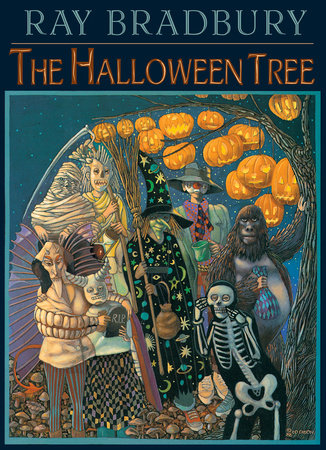I first read The Halloween Tree in middle school, when a teacher who must have really loved this story photocopied the whole book for the twenty or so students in his Reading class. It was the sort of book I didn’t mind being assigned: fun and spooky, and seemingly not very educational (although now I think it is). I eventually bought a paperback copy with incredible cover art by Leo and Diane Dillon, and dark, expressive illustrations by Joseph Mugnaini throughout. It’s a quick read at less than 150 pages, so I revisit it every couple years as the leaves start to fall.
The book is basically A Christmas Carol for Halloween: A horror-adjacent fantasy story where the protagonists need to learn the true meaning of the holiday before time runs out. The stakes are high: For Scrooge, his immortal soul is on the line; For Tom Skelton and seven other boys in small-town Illinois, it’s the life of their sick friend Joe Pipkin. Where Scrooge is guided by Christmas spirits, the boys are led by the skeletal Carapace Clavicle Moundshroud, a supernatural man who perfectly embodies the trick-or-treat spirit. To save Pipkin, Tom and friends will need to journey through time and space to find the origins of their costumes: skeleton, mummy, witch, gargoyle, ape-man, and the grim reaper himself.
Ray Bradbury’s energetic writing does a great job capturing the feeling of Halloween and distilling its essence. It’s about death, sure, but also about change and time and survival and memory. Our ancestors harnessing fire to keep predators at bay, giving them more time to spin stories and create culture. Using myth to understand the daily death of the sun and it’s rebirth each morning. Dreading the annual chill of winter and rejoicing at spring’s explosion of life. Fearing death always, but celebrating life while we have it, and remembering loved ones when they’re gone.
Long before I was ever interested in paganism, this book revealed the pagan roots of a holiday that has been adapted and absorbed into Christianity and secular culture. But, as the author points out, our culture (at least in America) seems to be all treat and no trick these days. We desperately need a reminder of our mortality, if only for one night each year. We need that perspective on death in order to appreciate life fully while we can.
2020 has been a year of death and trauma. It’s also the year that our daughter is beginning to understand that every living thing has an ending. The bug that’s not moving isn’t just asleep: Its lifetime has come to an end. That understanding is a kind of death in itself: Our joyful, innocent child is learning a dark truth that will stay with her.
Learning about death changes you forever. And while you can never unlearn that essential fact of life, our culture does a great job of distracting us from the weight of it. Maybe we need a periodic reminder. Halloween, in all it’s shapes and incarnations, is a season of remembrance. The Halloween Tree helps me remember, and I know I’ll pass it on to our daughter when the time is right.
